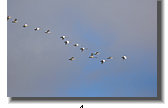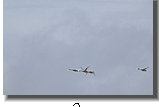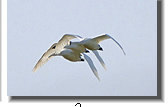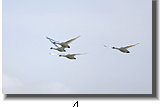|
|
|
Many years ago I was often laying down in barley fields in the Klamath Basin among hundreds of goose decoys, often for whole days at a time . Sometimes the temperature was down to 4 degrees. And sometimes the only thing flying were the Tundra Swans. In those flat agricultural fields they tended to motor around in their stately fashion very low to the ground, often under 5 feet, and they seemed to like to buzz the goose decoys. I was often passed right over at a height I could have reaced up and touched the swan. Under those conditions, with the heaviest of all long- flying birds on earth passing right over one's head, you learn things you would never imagine. Like...they SQUEEK and CREAK! All those bones an ligaments flexing and bending under great strain, with each stately wingbeat... squeek..creak.....squeek..creak......squeek..creak.
Compared to swans, ducks in flight seem like mosquitos and geese seem like sparrows. Swans fly with such a slow and steady wingbeat cadence, such a straight and steady path that they remind me of a train on a track, as though flying on rails on a predetermined laser path. And when one finally sees them side on one must wonder at the aerodynamics with that long neck and head leading the way...way out there..with the motor in the rear coach. But it undeniably works.
Once commercially hunted almost to extinction, Tundra (formerly Whistling) Swans have now made such a comeback that the population could easily support hunting. But the human population has no killer lust for it. Years ago I learned first hand what public outrage awaits anyone who suggests in the local paper that there is no difference between shooting a swan than a goose.
|








